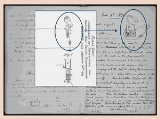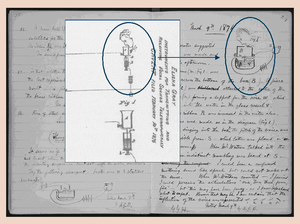
The Telephone Gambit
Encyclopedia
The Telephone Gambit is a 2008 book by Seth Shulman about the Elisha Gray and Alexander Bell telephone controversy. It explains how an inside source at the patent office apparently enabled Bell to gain access to and to steal Elisha Gray's invention.
 The Telephone Gambit: Chasing Alexander Graham Bell's Secret by Seth Shulman (W.W. Norton, 2008) notes that:
The Telephone Gambit: Chasing Alexander Graham Bell's Secret by Seth Shulman (W.W. Norton, 2008) notes that:
Evenson admits that Bell's lawyer knew about Gray's water transmitter design before Bell's patent was filed at the Patent Office on February 14, 1876, but he also argues that Bell tested Gray's water transmitter design only after Bell's patent was granted on March 7 and only as a proof of concept
scientific experiment to prove to his own satisfaction that intelligible "articulate speech" (Bell's words) could be electrically transmitted. After March 1876, Bell focused on improving the electromagnetic telephone and never used Gray's liquid transmitter in public demonstrations or commercial use.

- Bell's notebook records his making small incremental changes every day for months, mostly concerned with his wish to transmit multiple telegraph messages over a single transmission line using a system of critically tuned vibrating reeds.
- On 12 January, 1876, Bell makes 3 copies of his original patent application.
- On 25 January, 1876 one copy is given to George Brown to take by ship to England; but this copy has no penciled margin addenda and does not describe any sort of variable resistance telephone.
- On February 14, 1876 Elisha Gray files a "caveat" (like a provisional patent application) for a variable resistance telephone.
- Also on February 14, 1876 the Bell telephone patent is filed. But because no time-of-day stamp is placed on submissions such as caveats and patents, it is unclear which submission arrives first.
- Bell's patent submission is divided into 5 parts, only the last one of which (penciled onto the margin of the original) describes a telephone. The main emphasis of Bell's patent is focused on telegraph technology, an area of keen interest to Bell's financially powerful sponsor Gardiner Hubbard, whose daughter Bell wishes to marry.
- On February 19, 1876 the patent office says it will suspend Bell's patent for three months until it can decide whether or not to begin proceedings to determine whether Bell or Gray invented the telephone first.
- On February 24, 1876 Bell leaves for Washington and is absent from his experimental work until he returns to Boston two weeks later.
- Bell's patent is issued on March 7, even though most patents from this period take months or years to issue.
- On March 9, 1876 Bell "introduces a striking contraption: a diaphragm with a needle sticking through it into ... acidic water".
- Bell's striking contraption is similar to the one in Gray's caveat.
- Bell does not manage to get the telephone to work until March 10, 1876, even though the patent office normally required a working model to be submitted along with the patent application.
- On April 8th, 1886, Patent Examiner Zenas Fisk Wilber in a sworn affidavit admits receiving $100 from Bell for showing him the original drawing of the telephone transmitter in Gray's caveat.
- The world famous scene in which Bell and Watson make their first telephone call is described in his autobiography by Thomas A. WatsonThomas A. WatsonThomas Augustus Watson was an assistant to Alexander Graham Bell, notably in the invention of the telephone in 1876. He is best known because his name was one of the first words spoken over the telephone. "Mr. Watson - Come here - I want to see you." were the first words Bell said using the new...
some year's after Bell's death. Bell’s reluctance to talk about or celebrate this event is attributed to his everlasting embarrassment over his unethical treatment of Elisha Gray.
Rebuttal to Shulman's theory
- Evenson, A. Edward (2000), The Telephone Patent Conspiracy of 1876: The Elisha Gray - Alexander Bell Controversy, McFarland, North Carolina, 2000. ISBN 0-7864-0883-9
Evenson admits that Bell's lawyer knew about Gray's water transmitter design before Bell's patent was filed at the Patent Office on February 14, 1876, but he also argues that Bell tested Gray's water transmitter design only after Bell's patent was granted on March 7 and only as a proof of concept
Proof of concept
A proof of concept or a proof of principle is a realization of a certain method or idea to demonstrate its feasibility, or a demonstration in principle, whose purpose is to verify that some concept or theory that has the potential of being used...
scientific experiment to prove to his own satisfaction that intelligible "articulate speech" (Bell's words) could be electrically transmitted. After March 1876, Bell focused on improving the electromagnetic telephone and never used Gray's liquid transmitter in public demonstrations or commercial use.
External links
- Review at Boston Globe
- Review at Christian Science Monitor
- Review at Entertainment WeeklyEntertainment WeeklyEntertainment Weekly is an American magazine, published by the Time division of Time Warner, that covers film, television, music, broadway theatre, books and popular culture...

